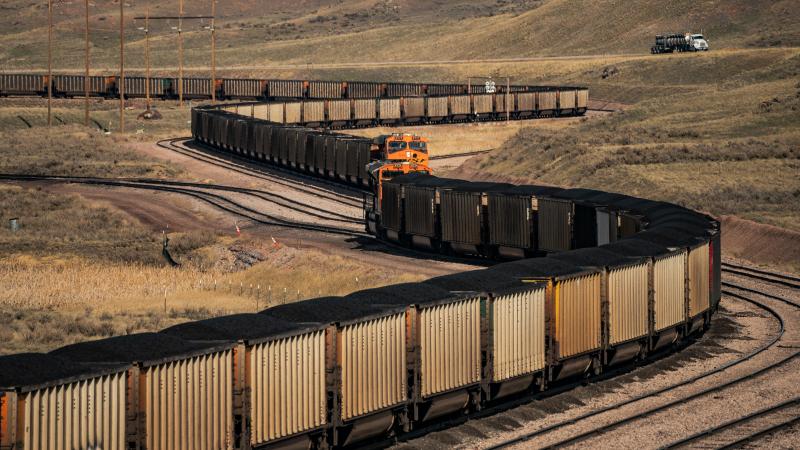Solar developments are spreading across America, threatening farmers and local communities
As more land -- and taxpayer money -- goes to solar projects, farmers and ranchers are becoming another voice in the local opposition as increasingly scarce farm and rangeland is gobbled up for renewable energy.
Fueled by massive federal subsidies in the Inflation Reduction Act (IRA), solar developers are looking to the wide open spaces of rural lands as the best places to site their projects. This is also where much of America’s farm and range land is located, as well as communities that like the existing look and character of their neighborhoods.
Last week, President Biden said of the IRA, “I’m proud to announce that my, uh, my investments, that through my investments, the most significant climate change law ever. And by the way, it is a $369 billion bill. It’s called the — uh, we, we should have named it what it was.”
Solar energy is among the most land-intensive forms of energy of all the different types of electrical generation. Per unit of electricity produced, ground-level solar installations take up more space than conventional coal. As more land goes to solar projects, farmers and ranchers are becoming another voice in the local opposition as increasingly scarce farm and rangeland is gobbled up for renewable energy.
As the supply of agrarian land diminishes, agriculture experts say, the cost of buying farm land goes up. That impacts food prices and creates a barrier to entry for new farmers. Fewer farmers and less land to farm could threaten the ability of the U.S. to maintain its own food supply.
Brendan Shea, commissioner-elect for Madison County, Ohio, told Just the News that the county has lost 10,000 acres to renewable energy developments. Another 6,000 acres may be lost if another project gets final approval. He said as the number of farms shrinks, opportunities in the ag industry are shrinking along with it.
“There's definite impacts on the ag economy. Industry and suppliers that serve the ag economy, we’ve seen layoffs and problems like that,” Shae said.
To show the size and scope of solar projects in Madison County, Shae took a flight over existing projects and land designated for the proposed 6000-acre project. The proposed project will be built on land owned by Bill Gates, he says in the video. County officials are appealing against the state’s approval of the project.
The project would generate up to 800 megawatts of intermittent power, because it functions only when the sun is shining. He compares that to the Lordstown Energy Center gas-fired power plant near Youngstown, Ohio, which generates 940 megawatts on 17 acres and produces on-demand power nearly continuously.
Based on the average U.S. home consumption of approximately 899,000 watt hours per month, a 940-megawatt gas plant running for one month could power approximately 1,045 homes, depending on energy demand. Solar farms produce energy intermittently, so the total watt hours per month any farm produces depends on the amount of sunshine and clouds.
Suitable for development
While solar produces electricity without carbon dioxide emissions, its land demands are leading to a number of land-use conflicts. According to the Renewable Rejection Database, which is maintained by energy expert Robert Bryce, there have been 58 rejections or restrictions of solar energy projects in the U.S. this year. Since 2017, there have been 274.
Citing figures from a Lawrence Berkeley National Laboratory survey, Bryce writes on his Substack that some of the top reasons rural communities reject the projects is because of the loss of ag land, the impact to their viewsheds, and lower residential property values.
The Bureau of Land Management last month announced that it had identified 31 million rural acres of public land across 11 states of the U.S. West as suitable for solar development.
“Imagine if the Biden administration was saying they were going to release all this land for oil and gas. What would be the response of the Sierra Club, NRDC and the rest of them? They would be outraged. But now, because it's solar or wind … crickets. This is another example of the complete environmental betrayal by these climate NGOs,” Bryce said in an interview.
The BLM designated a large portion of Wyoming as suitable for solar, and Anne Brande, executive director of the Albany County Conservancy in Wyoming, told Just the News that the impacts go beyond the destruction of rangeland.
“Residents and visitors rank western views, wildlife, history, and outdoor recreation as their highest values. Solar impacts all of this,” Brande said.
Among the issues, she said, is that the BLM’s environmental impact statement for the solar plan is allowing development on slopes of up to 10%, an increase from 5% over the previous rules. This will increase soil erosion in the desert ecosystem. She said extensive solar development will add to the cumulative impact of the wind industry on Wyoming.
“Migratory birds in flyways are already negatively impacted by wind and transmission. Impacts on these populations kill. With 21 contiguous wind projects, associated transmission lines, and now 3 million acres available for solar, the future for Wyoming wildlife and historic sites is bleak,” she said.
Competing for land
Linda Pryor, farm manager at Hilltop Farm, an apple and corn farm in North Carolina, told Just the News that a big part of the problem is the diminishing profitability and sustainability of agriculture. She said it’s important to respect property rights and let people do what they want with their own land, even if it’s to develop solar, but she would like to see agriculture be a more attractive investment.
Pryor recently testified before the House Energy Committee hearing on "energy poverty." She talked about how energy costs are driving up the costs of all inputs on farms, including fuel costs, which is making it harder for farms to be profitable and driving up food costs for consumers.
“If it's not profitable to farm on, then they [landowners] sometimes have no other choice but to look at other options, and sometimes solar being one of those,” she said in an interview.
The massive subsidies pouring into renewable energy create a lopsided competition between solar and agriculture. The Inflation Reduction Act provides up to $3 trillion in energy subsidies, and these incentivize companies to build more solar energy, even when it doesn’t make sense from a business standpoint.
Shae, the county commissioner in Ohio, said the state passed a law in 2021 that grants local governments more authority to reject solar projects. “I do think you will see a slowdown in Ohio because of that,” he said.
The Lawrence Berkeley National Lab survey found that, according to 123 people surveyed from 62 alt-energy companies, the leading causes of solar project cancellation were local ordinances and zoning, grid interconnection, and community opposition. Faced with the formidable force of local opposition, some states, unlike Ohio, are trying to reduce local authority for granting permits to these projects.
Bryce said local opposition is one of the primary barriers to renewable projects because the people most directly impacted by the projects are going to be the most vocal in opposing them.
“In my experience over and over again in reporting on these issues is that local people everywhere, around the world, care about their neighborhoods. Of course, they're going to resist the encroachment of these massive wind and solar projects,” Bryce said.
The Facts Inside Our Reporter's Notebook
Links
- President Biden said of the IRA
- most land-intensive forms of energy
- increasingly scarce
- 899,000 watt hours per month
- Renewable Rejection Database
- Lawrence Berkeley National Laboratory survey,
- rural communities reject the projects
- suitable for solar development
- Hilltop Farm
- recently testified before the House Energy Committee
- $3 trillion in energy subsidies
- doesnât make sense from a business standpoint
- reduce local authority
















